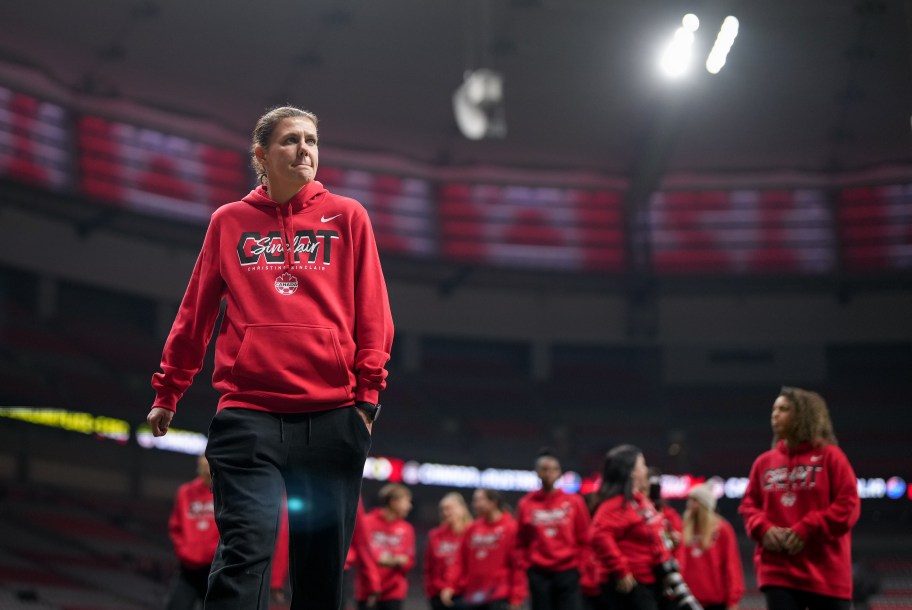Christine Sinclair bids farewell to Team Canada on home turf
Christine Sinclair‘s final game as part of Team Canada marks an inflection point not just in her life, but in all of ours.
The legendary Canadian captain was feted in her farewell match on Tuesday night at Vancouver’s BC Place, temporarily renamed Christine Sinclair Place. The match, a 1-0 Canada win, was the second in a week in Sinclair’s home province, following a 5-0 Canada win on Friday night in Langford.
The emotional pre-game ceremony on Tuesday featured numerous Olympians, including Charmaine Crooks, Catriona Le May Doan and most of Canada’s bronze-medal-winning London 2012 side. While Sinclair’s retirement was the main draw, Sophie Schmidt and Erin McLeod were also acknowledged for their long-time contributions to the squad.
Sinclair got the start, making her 331st and final appearance for Canada. Then in the 58th minute, to a thunderous ovation from the 48,000 fans in attendance, she was substituted out. She handed the captain’s armband to Schmidt, gave her longtime teammate a big hug, and left the pitch.
And now… well, that’s it. Never again will Sinclair’s name appear on a Team Canada roster. The once unfathomable, now unavoidable.
Everyone’s life hangs on such inevitable moments that feel forever away until suddenly they’ve arrived. No team in Canada, and few on Earth, have found their identity as intertwined with a single player as the women’s national soccer team and Sinclair.
We aren’t just bidding farewell to Sinclair, or her fellow generation of Canadian players. We’re turning the page on a particular idea of what the women’s national team is, and what it can be.
On the way up
Sinclair’s national team career began back in 2000. That was just one year after the famous “sports bra celebration” by the USA’s Brandi Chastain in the 1999 FIFA Women’s World Cup final. That tournament catapulted women’s soccer into the global spotlight for the first time.
It provided young female players everywhere with a template of what was possible. Sinclair, blessed with a generational blend of speed, strength, and finishing ability was one such player. Before long, Canada’s tactical game plan followed a predictable-but-effective pattern: get the ball to Christine.
At the next FIFA Women’s World Cup in 2003, Canada finished fourth and Sinclair was one the tournament’s top scorers. Now, suddenly, Canada was a team that could be competitive in big competitions.
READ: The career highlights of goal-scoring GOAT Christine Sinclair
At Beijing 2008, Canada competed in the women’s Olympic soccer tournament for the first time. Sinclair scored twice and Canada reached the quarterfinals. Now, success at the Olympics was within striking distance.

Four years later, at London 2012… well, we all remember. Sinclair’s hat trick heroics nearly lifted Canada above the USA in that epic semifinal. But the momentum carried through into a successful bronze medal match.
And now, the Olympic podium was attainable for Canada, perhaps even expected. All the while, the thinking went, the team would go as far as its captain would take them.
Sinclair, you see, absolutely turned up in the big moments. But she also turned up at nearly every moment in between. For two decades, she was a goal-scoring machine.
She’s the most prolific scorer in the history of international soccer, with 190 goals for Canada. She’s stood as one of the game’s true superstars during its remarkable evolution in the last 20 years.
She has, quite possibly, had more global impact than any other Canadian team sport athlete in history.
And that’s why the question’s been asked for many years now: what on Earth will the Canadian team do without her?

What now?
Fortunately, the last few years have provided a rather encouraging answer to that question. They will follow in Sinclair’s footsteps. Not a singular she, but a collective they.
Sinclair, who turned 40 this year, has gone out on her own terms. Plenty of players have skill, but too many find their potential cut short by injuries or other factors beyond their control.
Sinclair, however, wasn’t cut down in her prime. She wasn’t forced out of the team prematurely, nor did vanity compel her to hang on for too long.
READ: Golden generation lifts iconic Sinclair to the Olympic pinnacle
As her 30s went on, she adapted her playing style and her role within the team. She mentored young players and offered an inspirational spark that only someone of her pedigree could provide.
The “get the ball to Christine” years have long since passed. In recent years, Canadian players were just as likely to be getting the ball from Christine in front of the opponent’s net. The symbolism hasn’t been lost on anyone.

So as she steps away to take the well-deserved next step in her life, Sinclair isn’t leaving behind a shell that will crumble to dust in her absence.
Canada is no longer a scrappy, upstart squad who became big fish in a small pond thanks to one magical player. Canada is an established fish in a rapidly growing and diversifying pond, where the current changes quickly and only the adaptable survive.
It’s an incredibly exciting time for women’s soccer, and Christine Sinclair helped build all of this. Not just for fans in Canada, but worldwide. While Canadians will feel her absence most acutely, the sport itself will be a tad different in the months and years to come.
For years, people wondered who the “next” Christine Sinclair would be. When the day comes that she leaves the Canadian team, who’s going to take the baton and keep running with it like she did?
Now that the day has arrived, we know three things for sure.
There is no next Christine Sinclair. There was never going to be. And that is perfectly fine.


